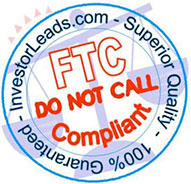Financial Leads Information 2
Want to make your marketing campaign a success?
Then you need to use financial sales leads that are customized for your specific industry.
If we had published this article during the dotcom boom of the late 1990s, there’s no doubt we would have been laughed at. Back then, everything was going up in double-digit percentages, and nobody wanted to fool around with the meager 2-3% gain from dividends. After all, we were in the new economy: the rules had changed and companies that paid dividends were “too old economy”.
As Bob Dylan once sang, “The times, they are a-changing’.” After the bull market of the ’90s ended, the fickle mob once again found dividends attractive. For many investors, dividend-paying stocks have come to make a lot of sense. In this article, we’ll explain what dividends are and how you can make them work for you.
Background on Dividends
A dividend is a cash payment from a company’s earnings, announced by a company’s board of directors and distributed among stockholders. In other words, dividends are an investor’s share of a company’s profits, given to him or her as a part-owner of the company. Aside from option strategies, dividends are the only way for investors to profit from ownership of stock without eliminating their stake in the company.
When a company earns profits from operations, management can do one of two things with the profits. It can choose to retain them – essentially reinvesting them into the company with the hopes of creating more profits and thus further stock appreciation. The other alternative is to distribute a portion of the profits to shareholders in the form of dividends. (Management can also opt to repurchase some of its own shares – a move that would also benefit shareholders. Read more about it in The Lowdown on Stock Buybacks.)
A company must keep growing at an above-average pace to justify reinvesting in itself rather than paying a dividend. Generally speaking, when a company’s growth slows, its stock won’t climb as much, and dividends will be necessary to keep shareholders around. This growth slowdown happens to virtually all companies after they attain a large market capitalization. A company will simply reach a size at which it no longer has the potential to grow at annual rates of 30-40% like a small cap, regardless of how much money is plowed back into it. At a certain point, the law of large numbers makes a mega-cap company and outperforming growth rates which outperform the market an impossible combination.
The changes witnessed in Microsoft in the last few years are a perfect illustration of what can happen when a firm’s growth levels off. In Jan 2003, the company finally announced that it would pay a dividend: Microsoft had so much cash in the bank that it simply couldn’t find enough worthwhile projects in which to invest – you can’t be a high-flying growth stock forever!
The fact that Microsoft started to pay dividends did not signal the company’s demise; it simply indicated that Microsoft had become a huge company and had entered a new stage in its life cycle, which meant it probably would not be able to double and triple at the pace it once did.
Dividends Won’t Mislead You
By choosing to pay dividends, management is essentially conceding that profits from operations are better off being distributed to the shareholders than being put back into the company. In other words, management feels that reinvesting profits to try to achieve further growth will not offer the shareholder as high a return as a distribution in the form of dividends.
There is another motivation for a company to pay dividends: a steadily increasing dividend payout is viewed as a strong indication of a company’s continuing success. The great thing about dividends is that they can’t be faked. They are either paid or not paid, increased or not increased.
This isn’t the case with earnings, which are basically an accountant’s best guess of a company’s profitability. All too often, companies must restate their past reported earnings because of aggressive accounting practices, and this can cause considerable trouble for investors, who may have already based future stock price predictions on these (unreliable) historical earnings. (To learn more about earnings manipulation, read Understanding Pro-Forma Earnings and Cooking the Books 101.)
Expected growth rates are also unreliable. A company can talk a big game about wonderful growth opportunities that will pay off several years down the road, but there are no guarantees that it will make the most of its reinvested earnings. When a company’s robust plans for the future (which impact its share price today) fail to materialize, your portfolio will very likely take a hit.
However, you can rest assured that no accountant can restate dividends and take back your dividend check. Moreover, dividends can’t be squandered away by the company on business expansions that don’t pan out. The dividends you receive from your stocks are 100% yours. You can use them to do anything you like: pay down your mortgage, spend it as discretionary income or buy the stock of a company you think has better growth prospects.
Who Determines Dividend Policy?
The company’s board of directors decides what percentage of earnings will be paid out to shareholders, and then puts the remaining profits back into the company. Although dividends are usually dispersed quarterly, it is important to remember that the company is not obligated to pay a dividend every single quarter. In fact, the company can stop paying a dividend at any time, but this is rare, especially for a firm with a long history of dividend payments.
If people were used to getting their quarterly dividends from a mature company, a sudden stop in payments to investors would be akin to corporate financial suicide. Unless the decision to discontinue dividend payments was backed by some kind of strategy shift, say investing all retained earnings into robust expansion projects, it would indicate that something was fundamentally wrong with the company. For this reason, the board of directors will usually go to great lengths to keep paying at least the same dividend amount.
How Stocks That Pay Dividends Resemble Bonds
When assessing the pros and cons of dividend-paying stocks, you will also want to consider their volatility and share price performance as compared to those of outright growth stocks that pay no dividends. (For further reading, see The Power of Dividend Growth.)
Because public companies generally face adverse reactions from the marketplace if they discontinue or reduce their dividend payments, investors can be reasonably certain they will receive dividend income on a regular basis, for as long as they hold their shares. Therefore, investors tend to rely on dividends in much the same way that they rely on interest payments from corporate bonds and debentures.
Since they can be regarded as quasi-bonds, dividend-paying stocks tend to exhibit pricing characteristics that are moderately different from those of growth stocks. This is because they provide regular income, similar to a bond, but still provide investors with the potential to benefit from share price appreciation if the company does well.
Investors looking for exposure to the growth potential of the equity market, combined with the safety of the (moderately) fixed income provided by dividends, should consider adding stocks with high dividend yields to their portfolio. A portfolio with dividend-paying stocks is likely to see less price volatility than a growth stock portfolio.
Conclusion
A company can’t keep growing forever. When it reaches a certain size and exhausts its growth potential, distributing dividends is perhaps the best way for management to ensure shareholders receive a return from the company’s earnings. A dividend announcement may be a sign that a company’s growth has slowed, but it is also evidence of a sustainable capacity to make money. This sustainable income will likely produce some price stability when paid out regularly as dividends. Best of all, the cash in your hand is proof that the earnings are really there, and you can reinvest or spend them as you see fit.
To read more on this subject, see Dividend Facts You May Not Know.
For more detailed information on the topics below for our accredited email investor lists, visit the links using top of the page navigation menu.
exclusive:
We receive new investor names monthly and give a 180-day exclusive on each lead. We guarantee 100% that the sales leads are clean and “unhammered”.
100% satisfaction guarantee
Our leads are continuously cleaned and updated monthly in order to provide our clients with the cleanest, most accurate information possible on each investor. All of our investor leads are guaranteed to be 100% accurate. We will replace any record that is in error. 100% SATISFACTION GUARANTEED
pricing:
As a small company with low overhead, we are able to provide you with highly-qualified investors at very competitive prices. If you find a lower price, please let us know. We will beat any advertised price, just ask!
delivery:
We can E-mail your leads to you immediately, receive your leads within 1 hour, no shipping charges (for special orders delivery time may vary).
For any printed material (3×4 Cards, Paper, Mailing Labels) overnight delivery available upon request: UPS, FedEx, DHL, USPS
payment:
We accept the following payment methods: Visa, Master Card, AMEX, Discover, Company Check, Money Order, Cashiers Check, Wire Transfer, WesternUnion, Paypal.
To send money to us via Pay Pal please send your payments to: Info @ Investor Leads.com (without the spaces)
To contact our main office:
voice: 561-208-6060
fax: 877-315-4146
e-mail: info @ investor leads.com (please remove the extra spaces)
1438 W Lantana Rd Ste 275
Lantana, FL 33462



